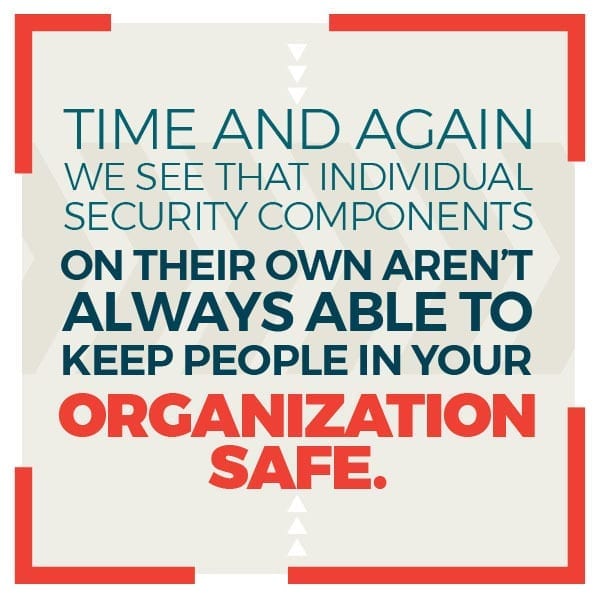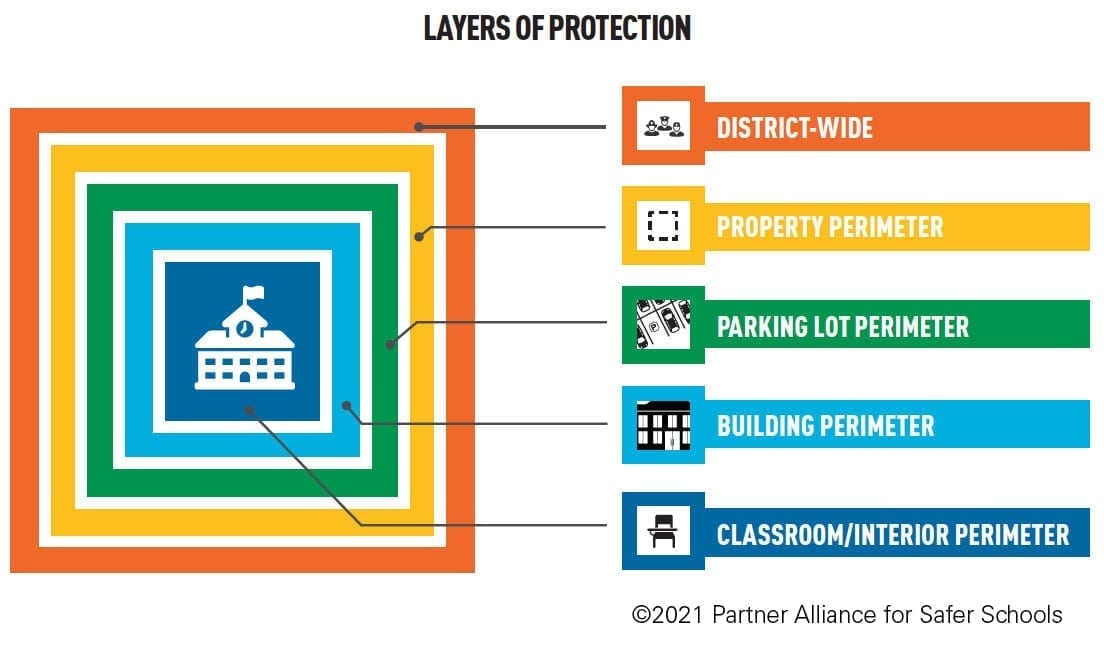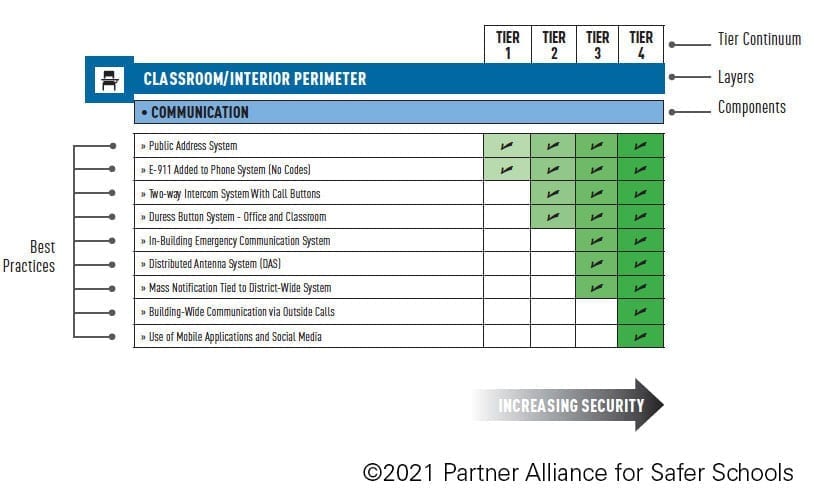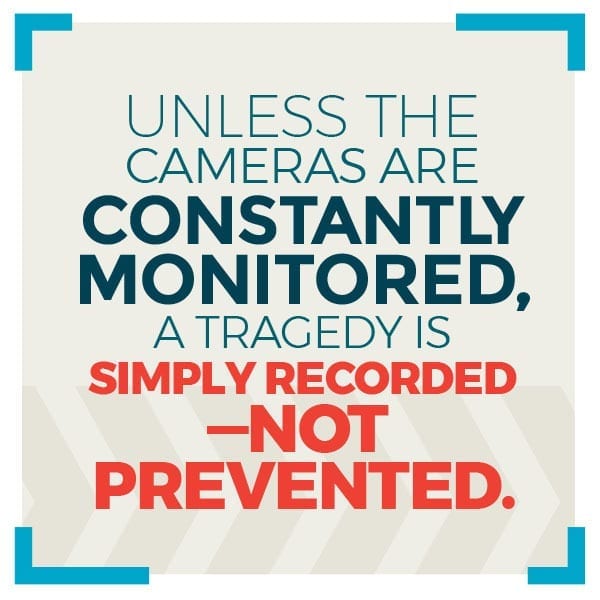Originally published on 3/4/21. Last updated on 3/7/23.
Layered security is no longer a complex strategy seemingly reserved for government buildings or other high-profile facilities. The increase in mass shootings, targeted violence, and other safety breaches in our schools, hospitals, and communities have painted a clear picture that layered security should be the baseline.
Unfortunately, time and again, we reap the consequences of individual security components that can’t always keep people safe on their own.
What do these layers actually look like? Which security components work best together? And how do you know those components and layers are at their most secure level?
The Partner Alliance for Safer Schools (PASS) answers these questions in Safety and Security Guidelines for K-12 Schools. PASS’s guidelines provide recommendations and best practices for implementing layered security in schools across the country. Although specific to K-12 schools, their recommendations provide a guideline for any organization looking to build an effective and comprehensive layered security plan.
PASS recommends looking at all of the areas of a school as layers that need to be included in a security plan—from the entire school district down to each individual classroom.
The best way to avoid harmful incidents is to plan for them in advance and take preventative action. Security cameras are a critical piece of the safety puzzle, but if they’re only used after the fact—rather than proactively—then they are not being utilized to their full extent.
Consider that parking garages and lots are the third most common place for murder and assault, according to the FBI. These areas are often covered by surveillance cameras, but unless the cameras are constantly monitored, a tragedy is simply recorded—not prevented. What’s more, live monitoring is a monotonous and error-prone task. Even when cameras are actively monitored, threats (like drawn guns) are often missed due to human error.
Threats to safety can also come from unintentional actions. Imagine this all-too-common scenario:
A grocery store nears its closing hour and one of the last customers of the night spills their drink. The security cameras record the spill, but no one is monitoring them, and no action is taken. On her way out, the night manager slips on the spill and falls, rendering her unable to walk on her own or call for help. The next morning she’s found by the day manager and is taken to the hospital, where they determine her injuries will sideline her for an extended period. Besides having an injured employee, the store now faces injury-related costs and duties that need to be filled on short notice. Had the spill been detected and staff alerted to its presence, the consequences could have been avoided.
In 2019, a patient experiencing a mental health crisis walked into an Orangeburg, SC, hospital with a loaded semi-automatic rifle and began firing into a crowded hallway. Miraculously no one was killed, but could the tragedy have been prevented if the hospital had been using layered security with proactive defense solutions in place? Automatic door locks, metal detectors and other access controls can be very effective when used as proactive security measures. How can they be proactive if there isn’t any security alert or indication prior to a crisis taking place though?
IntelliSee adds a complementary layer of security to your existing surveillance without adding personnel, disruptive renovations or expensive upgrades. By autonomously monitoring your existing security cameras in real-time, IntelliSee allows you to proactively identify threats. Once a threat—such as a drawn gun, spill, trespasser, etc.—is detected, IntelliSee alerts your people and systems instantly so you can act before an incident occurs. If an incident does occur, IntelliSee’s proactive detection can greatly reduce response times and the severity of outcomes.
Threats to safety can still occur, but with IntelliSee, you gain awareness and the opportunity to respond proactively. For instance:
- A patient experiencing a mental health crisis, disgruntled employee or violent criminal pulls a gun from a vehicle in your parking lot. IntelliSee, working on your existing cameras, detects the gun as they approach, and a critical alert is sent immediately for review. The risk is assessed, door locks are activated, employees take cover, and the police respond. The perpetrator is apprehended before shots are fired.
- A customer spills their beverage in a grocery store. IntelliSee detects and validates the spill, and an alert is sent to the shift manager. The spill is still there 15 minutes later, and an escalated alert is sent to the shift and store managers. The spill is cleaned minutes later before customers slip and fall, potentially injuring themselves.
- An ER nurse walking to her car after a 12-hour shift is suddenly attacked by a perpetrator in the hospital parking lot. If the perpetrator has a drawn gun, IntelliSee detects the weapon and immediately sends an alert to hospital security, who then notify the police. The security guards arrive in time to save the woman’s life and the police are able to apprehend the offender.
If the perpetrator doesn’t have a drawn gun, IntelliSee detects a trespasser or fallen person, sends an immediate alert, and initiates a potentially life-saving response.
Both incidents are still tragic, but the worst-case scenario was prevented.
When used as part of a layered security strategy, the IntelliSee AI risk mitigation platform can dramatically improve the safety of your organization, your people, and those you serve. Imagine what IntelliSee can do as the proactive piece for your layered security plan.
Interested in a live demo? Let us know if you’re ready to see what AI-enhanced defense can bring to your layered security.




